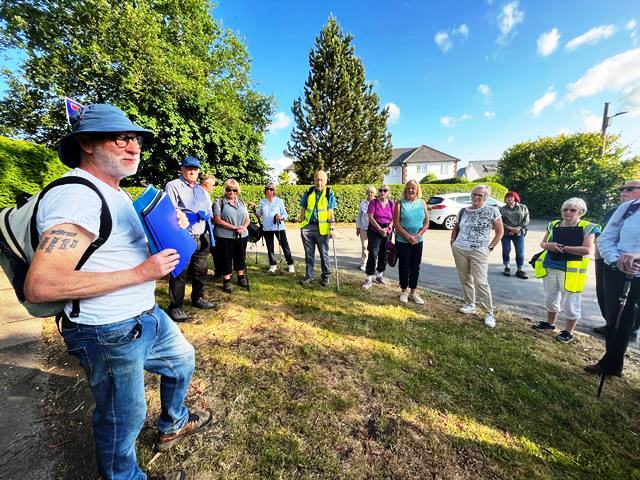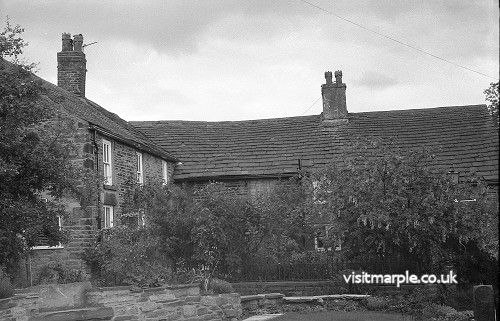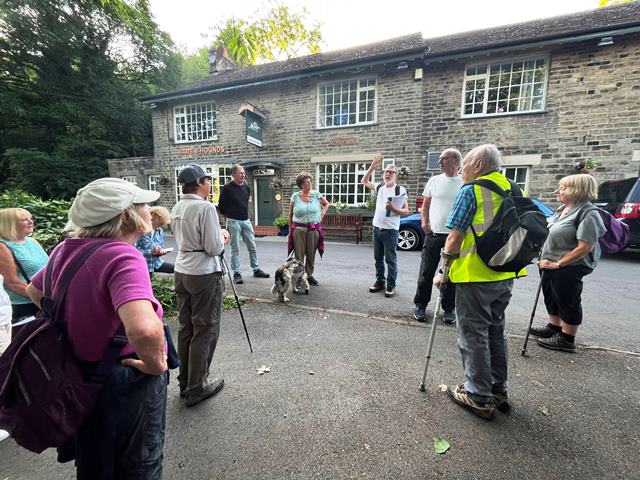On a fine sunny evening, about 20 of us set out from the top of Townscliffe Rd/Clement Road in Mellor, heading across the fields to Mill Brow, led by Frank Pleszak.

At the head of the road was Townscliffe Farm, built in 1790 with earlier sections. William Jowett, owner of Cateract Mill, lived in the house, but later it became the club house for Townscliffe Golf Club (1908) which amalgamated with Mellor Golf Club in 1920.
 Townscliffe Farm in 1981 [click the image for 'modern view]
Townscliffe Farm in 1981 [click the image for 'modern view]
On the horizon, looking East, a short upright lintel was the remains of a lime kiln at Knowle Farm.
Following the path to the left, brought us to Heathy Bank Farm, built in the 1700s. The outbuildings have been beautifully converted to separate dwellings. We continued through the farm and onto open fields.
In the distance (looking East) was Ludworth Moor, where the drift mines from the Ludworth Moor Colliery (started in 1927) were located. These became open cast mining for the last two years before closing in 1983.

Walking past the site of Clough Mill in the valley, we approached Mill Brow, where Primrose Mill lay next to Mill Brook. The stream formed the boundary between the townships of Mellor and Ludworth. The mill had field collection drains in the field, and a chimney concealed by the trees. Originally owned by the Stanney family, it was powered by water, but later by steam from 1826. The ‘lodge’ acted as a reservoir of water to power the steam engine. Since 1780 it’s produced several commodities including textiles, with dying and printing, Ramie gas mantles, and now mills rubber. Fires have reduced the size of the mill, latterly in 1960s, it's now up for sale. Three weavers cottages on the right were demolished in the 1930s, where donkeys are often kept.

We followed the road (called The Ramie) uphill, through land once owned by Lord Howard, the Duke of Norfolk, an old Catholic family. A stone inscribed with an ‘N’ is on the roadside. Half way up was Ludworth Corn Mill, the oldest mill in the area, dating back to the 1400s. The site is overgrown but a few walls can be seen, and one of its mill stones is set into the wall of the drive. In the 1920s it was destroyed by the dam bursting at Holly Head Bleach Works higher upstream
The private house (Brookside House) below it may have been a warehouse. 30 cottages used to stand on the opposite bank, called Dam Side, just the foundations remaining.
In Mill Brow, Pear Tree Farm has an early example of a cruck barn, visible from the road. The Methodist, John Wesley, may have preached there. The Hare and Hounds Pub started out as a beer house in 1805. Its car park is clearly a former quarry. In the fields behind the pub were Mill Brow brick and tile works, including a short incline tramway, lasting to the 1930s. Several other pubs existed in Mill Brow, including the Druid’s Arms, Sportsman’s Arms, all now private housing.
Holly Vale Chapel, primitive Methodist, was near the old smithy. The rough uphill road, Gird Lane, used to be the main road to Glossop from Marple, via Hollins Lane.
Holly Vale had a large spinning mill and bleach works belonging to the Radcliffe family from 1803-1900, the remains of which can still be seen over the wall. The private house, Hempfield, used to be the mill owner’s house. There was also a counting house, settling ponds for the bleach works, a gas works, and cottages for the weavers. The mill became derelict and was sold to Derbyshire County Council for £5 in 1930! The stone was used for roads.
We followed the track at the top end of Holly Vale, which joined footpaths up to Mellor Church. Both the old and new vicarages at Mellor Church used to be pubs (ale houses), and the track up to the Church was called Ale House Brow. A row of cottages, on the lower path to Mellor, included Blackberry Hall, where the owners of Primrose Mill used to live.

Frank was an excellent guide, and we all learned so much new information. Actually seeing the buildings and places brought history to life and gave us a much better understanding of how industrial Mill Brow used to be. Thank you very much, Frank!

